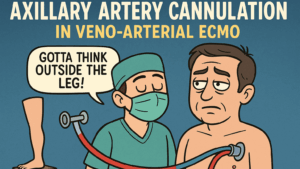The case study titled “Malignancy-Induced Functional Tricuspid Obstruction Complicated by Cardiopulmonary Collapse Treated Using Combination VA-ECMO and AngioVac”, published in JACC: Case Reports, presents a compelling narrative on the diagnostic and therapeutic utility of combining venoarterial extracorporeal membrane oxygenation (VA-ECMO) with large-bore vacuum-assisted aspiration thrombectomy for managing malignant intracardiac masses.
Case Overview
A 66-year-old woman presented with severe hypotension, grade IV jugular venous distention, altered mental status, and signs of systemic decompensation. Echocardiographic imaging revealed a large right atrial mass nearly occluding the tricuspid valve, resulting in obstructive shock. Further imaging identified metastatic disease with suspected lymphomatous involvement.
In a dramatic escalation of her condition, the patient experienced cardiac arrest during an attempted aspiration procedure. Emergency VA-ECMO was instituted to stabilize her hemodynamics, followed by successful percutaneous debulking of the tricuspid mass using the AngioVac system. Histopathologic analysis confirmed aggressive diffuse large B-cell lymphoma (DLBCL). The patient was extubated, stabilized, and later began intensive immunochemotherapy with excellent response. Six months post-intervention, she remains in good health and is on track for remission.
Technical Strategy: ECMO Meets Aspiration Thrombectomy
The VA-ECMO setup utilized a 19-F arterial return cannula and 25-F venous drainage cannula, connected to a standard circuit. The AngioVac system, FDA-approved for removing intravascular material, was employed for percutaneous aspiration through the jugular and femoral venous access points. The device’s large funnel permitted effective mass removal while maintaining hemodynamic stability through ECMO support.
Key advantages of this dual-modality approach included:
- Rapid stabilization via ECMO during cardiac arrest
- Effective mass debulking using AngioVac’s high-capacity suction
- Tissue sampling for rapid oncologic diagnosis
- Minimally invasive management, critical in hemodynamically compromised patients
Clinical Significance
This case underscores the growing role of mechanical circulatory support and advanced endovascular tools in managing complex oncologic cardiovascular emergencies. Malignancy-induced intracardiac masses are increasingly recognized as causes of shock and right heart failure. Traditional biopsy or surgical interventions are often not feasible in such unstable scenarios.
The AngioVac system, originally used for thrombus removal, demonstrated versatility in tumor debulking while preserving diagnostic tissue quality. Its role in mass removal—coupled with ECMO for circulatory support—proved essential in bridging the patient to diagnosis and definitive cancer therapy.
Challenges and Considerations
While aggressive, the intervention was justified by several factors:
- The patient’s condition was newly diagnosed without a known terminal prognosis.
- Obstruction relief was imperative to prevent fatal outcomes.
- Family consent and interdisciplinary agreement prioritized life-saving intervention.
Importantly, adjunctive techniques such as balloon stabilization or snare-assisted aspiration were not needed due to the AngioVac’s efficacy in this case. However, proceduralists should be prepared with such tools when addressing variable anatomy or mobile masses.
Follow-Up and Outcomes
Post-procedure, the patient required intensive care including pericardiocentesis and ventilation but showed rapid clinical improvement. She tolerated R-CHOP chemotherapy well and demonstrated normalized cardiac function on follow-up imaging. No neurologic deficits were observed, confirming the success of early intervention.
Conclusions and Broader Implications
This case highlights a paradigm shift in the acute management of malignancy-associated cardiac obstructions. Large-bore aspiration thrombectomy, traditionally reserved for thrombus removal, can be repurposed for rapid oncologic tissue acquisition and mechanical relief of obstructive masses. When combined with VA-ECMO, it offers a lifesaving bridge for unstable patients.
The report calls for increased awareness among cardiologists, oncologists, and critical care specialists of the potential for catheter-based therapies in cancer-related cardiac complications. The outcome also emphasizes the importance of:
- Multidisciplinary collaboration
- Rapid decision-making
- Innovation in procedural strategy
As device technology evolves and experience grows, more patients with complex cancer presentations may benefit from such minimally invasive, high-impact interventions.







